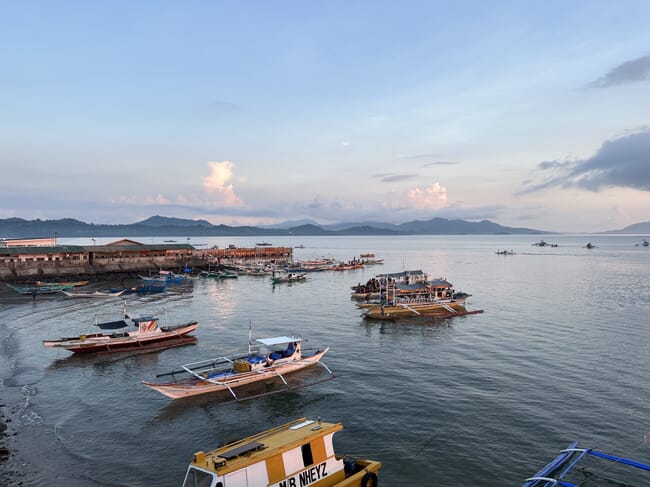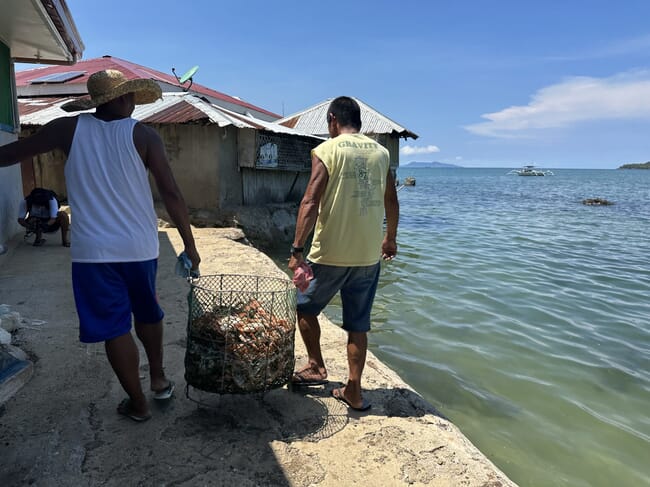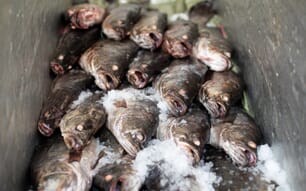
Wholechain is working on a traceability project for this fishery © Wholechain
Wholechain is a blockchain-based traceability system that was inspired by the founders’ experience in small-scale fisheries in Indonesia. Kaplan sees the increasing emphasis on seafood traceability as having a huge range of benefits – from reducing the environmental footprint of the industry, to improving working conditions and taking food safety to a new level.
According to Kaplan, it’s the latter that’s been prioritised by Western authorities like the Food and Drug Administration of the United States, whose updates to rule 204 of Food Safety Modernization Act will require full traceability of all seafood to the boat or farm. Wholechain has focused on simplifying compliance with the rule through its alignment with GS1 US and the Global Dialogue on Seafood Traceability (GDST) data standards, and Kaplan emphasises that ensuring food safety will have a range of knock-on benefits.
“If you lead with food safety, once deployed, you can have better monitoring of food waste. For example, we capture yield and sell-by dates and when product gets towards expiry food reclamation services can redirect it to food insecure communities. We’ve already done that four times in partnership with Copia, which also helps measure the water and carbon savings from sending the food to waste,” he explains.
Wholechain’s system has also helped to catch out at least one company that was involved in seafood fraud. Despite having credible certifications, the company in question had been falsifying their documentation – something that a simple chain of custody audit would have missed.
“We noticed an anomaly in the lot numbers. People can make mistakes, but after a bit of digging we saw that the flags on the vessels reported were changing from month to month and knew something was problematic. Sure enough they were bringing product in from a different country, via China,” Kaplan explains.
“We didn’t blame the certifiers, we blamed the supplier, who was truly criminal,” emphasises Kaplan.
A commitment to impact
Kaplan cut his professional teeth in the mobile marketing sphere, working on projects for multinationals across 38 countries.
His first close encounter with the seafood supply chain followed a move to Indonesia to work for a project for the US State Department. After encountering – and being a bit underwhelmed by – the activities of some of the development projects, Kaplan spent three years working on a project training small-scale fishers to use mobile tech as a means to improve their livelihoods.
“To make the impact I felt I had to actually work with the people who are getting in the boats and going out on the water,” he recalls.
And it was getting his feet in the water that helped to illustrate the issues facing the seafood sector – and the opportunity to fix them.
“Working on the supply side, rather than the demand side, of the value chain allowed me to see this huge disconnect between the market and the actual source of raw material, which is when I recognised the opportunity that was there,” he recalls.
Kaplan duly built in a messenger called mFish that – contrary to the expectations of many – proved that fishers were willing to share information on where they were fishing, and where they were catching the most fish. The system was based on giving users access to maps of the latest plankton blooms, to give them a better idea of where the shoals of fish were most likely to be.
“We created a phytoplankton map, which helped to reduce users’ catch times by 80 percent. Instead of blindly hunting on the ocean we visualised satellite imagery of phytoplankton on Google Maps,” Kaplan explains.
This allowed them to fine-tune where to fish, saving fuel and reducing their length of time spent at sea. This project is also where Kaplan met Wholechain’s co-founder Jayson Berryhill, who was working for the mobile network operator XL Axiata, which partnered with mFish.
Building a seafood firm
Following three years working with Unilever, as their VP of sustainable solutions, Kaplan and Berryhill teamed up to set up a seafood company, Envisible, alongside one devoted to ensuring traceability across the seafood supply chain, Wholechain.
The former sourced and managed seafood for private label retail grocers, while the latter helped to ensure traceability along the seafood supply chain.
“Traceability was the mission but we felt that without working in the supply chain itself we wouldn’t have the insights to develop the best traceability system, we would just be tech guys as outsiders guessing what’s going on. Envisible also helped to provide capital for Wholechain and made us less dependent on investors while we were building, while also giving us the insights to develop a product that is absolutely fit-for-purpose for seafood companies,” he recalls.
It also gave them vital insights into the level of cost that seafood businesses could actually absorb in order to adopt a robust traceability system.
“We asked one of the big three enterprise technology companies if we could use their system, but it would have cost us more than our entire year’s inventory for salmon,” Kaplan reflects.

© Wholechain
Diverse applications
They were also determined to develop a system that could be more widely applied.
“We also knew it was worth building it to be flexible – seafood doesn’t live in a vacuum. Soy is a big ingredient in aquaculture feed, so we wanted to have the ability, if asked, to do things other than seafood,” he explains.
It’s a strategy that seems to be paying dividends already.
“Seafood is still our focus, but we also trace vanilla, cattle, paper products, pomegranates and leafy greens,” he explains.
Envisible was sold last year, by which time Wholechain had crossed “the valley of death” which results in the end of so many startups, and had proved it was financially viable – thanks in part to being so widely applicable.
“It has a solution for every person in the supply chain. We wanted to deliver consumer transparency, as consumer demand drives everything; we wanted to deliver appropriate usability for the middle of the supply chain, like importers and processors; and, based on our background, we have a free mobile app for small scale producers. It makes data collection at the first mile very easy,” he notes.
“I think the use of traceability to enable small scale producers to have more equitable market access is something that I’m very proud of,” he adds.
As well as users, the system gained wider recognition, winning the FDA low-to-no-cost traceability challenge.
The company’s customers include Topco Associates, Thai Union, the Global Seafood Alliance, Orca Bay Seafoods, McCormick and many others tracing everything from farmed shrimp, tilapia, salmon, and tuna, to vanilla, soy, leather, recycled ocean-bound plastics and more. A forthcoming upgrade will further help Wholechain simplify traceability for customers to comply with current and upcoming regulations such as the European Union Deforestation Regulation (EUDR) and FDA Food Modernization Act Traceability Rule.
Kaplan is also fighting to ensure that people can differentiate between the event-based traceability aligned with industry standards like GS1 and GDST Wholechain does.
As he explains: "This traceability combines critical tracking events with key data elements to provide visibility, answering ‘What, Where, Why and How’, at every step of the seafood supply chain. . Alternatives like proprietary solutions and supply chain mapping tools that do not adhere to these standardized data frameworks lead to fragmentation and functional silos across the industry through the proliferation of proprietary data formats and traceability protocols. For instance, if a supplier uses a traceability system not based on standards for Retailer A, they cannot easily replicate data for Retailers B and C, despite selling the same product. This results in suppliers paying for redundant technologies and repeatedly collecting the same data in different formats, increasing costs, room for errors, data loss and manipulation, and ultimately more barriers to the adoption of traceability technology.
“Our biggest challenge right now is misinformation in the market place – and that’s a good thing. Definitions of traceability vary. Some people think that having the chain of custody, like using Fedex tracking number, counts as traceability. But while chain of custody only tells you where a product is at a specific time. Event-based traceability tells you who touched the product, if and how the product was transformed, and infinitely more details that an account owner might want to know about the product at each location along the supply chain.
“Yeah, great – you know that the product is there but you have absolutely no idea about what’s going on with it.”
While some producers might see the introduction of such a system as being a burden, or hard to justify financially, Kaplan believes that Wholechain’s technology, which includes the use of QR codes on seafood packaging, have helped to boost sales of traceable seafood.
“Even if only a few people scan the codes, letting the consumer know that someone is doing that does build confidence and credibility – consumer confidence is deservedly low: recall, slaves, fraudulent products, sodium tripolyphosphate, CO2-gassed tuna,” Kaplan reflects.

© Wholechain
Looking ahead
Other projects in Wholechain’s pipeline include the development of a system of mobile payments and incentives for small-scale producers; the development of worker voice capabilities, satellite environment monitoring and sensor interoperability.
“All of those capabilities are coming in the near term and they will help to provide a more robust ESG capability, above and beyond the food safety orientated matters,” says Kaplan.
Meanwhile, a number of plans to change regulations relating to international trade are likely to work in Wholechain’s favour.
For example an update to the US FDA’s Food Safety Modernization Act will require full traceability of high risk food items, including seafood. This was released in November 2022 and will be enforced from January 2026.
“The one that’s underappreciated in the US Uyghur Forced Labor Prevention Act, which is applicable for any forced labour. As it’s a customs and border force rule, the enforcement is substantially severe,” Kaplan points out.
Similarly, Europe is implementing its own changes.
“Europe’s green deal and anti-greenwashing rule, and deforestation-free products regulation, are also incredibly relevant for our business,” notes Kaplan.
“It’s nice when policy momentum not only supports your business but is also good for the planet,” he adds.
Global data standards
With such tailwinds working in Wholechain’s favour, Kaplan is looking to step up his efforts to educate people on the benefits of traceability and advocate for global data standards.
“Global data sharing is where we’re headed. Supply chain data will get to that point – every other technology has – with seafood leading, before moving across other commodities. We now need to look at how we can use traceability to help improve the use of deforestation-free soy and make it more available in aquaculture feed,” he reflects.
To do this Wholechain aims to double in size within a year, growing in line with demand.
“We want to use an inclusive approach and encourage people to use data standards. Wholechain is currently interoperable with other systems, even other traceability systems, enabling faster adoption across supplier networks. That seamless exchange in the spirit of simplifying traceability is in line with Wholechain’s mission of bringing transparency to global supply chains,” Kaplan reflects. However, despite welcoming competition in the space, Kaplan is convinced that Wholechain’s system is still hard to beat.
“We developed a fully traceable seafood assortment that’s retail-ready, scalable, and works. We managed to deliver this in 2020, during the pre-vaccine pandemic and I still haven’t seen any other system that provides detailed visibility from point of capture to consumption,” he concludes.








